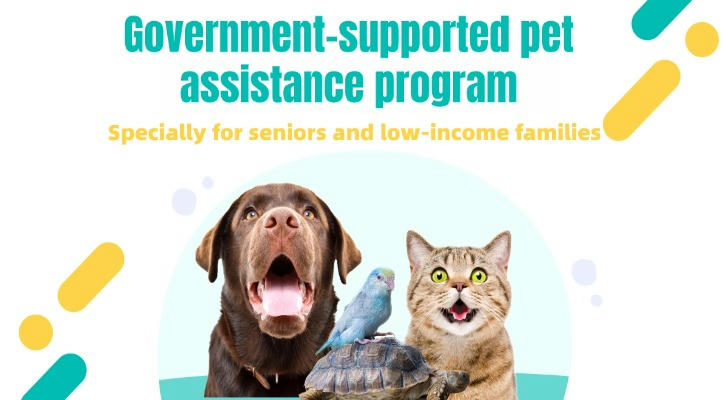🐾 A Guide to Government-supported Pet Assistance and Low-Cost Insurance in 2025
No Age Limit | Stable Premiums | A Secure Choice for Low-Income and Senior Families
In the United States, pets have become a part of the family. However, with veterinary costs rising, many seniors and low-income families struggle to afford pet care. State governments and insurance companies are now providing substantial assistance to these families through pet assistance programs and low-cost insurance.

🌟Why Seniors and Low-Income Families Need Pet Assistance and Insurance More Than Others
Against the backdrop of economic pressures and rising medical costs, pet healthcare expenses are increasing year by year.
- Routine checkups: Approximately $100–300
- Emergency surgeries: Can cost up to $2,000–5,000
- Chronic care (diabetes, kidney disease, arthritis, etc.): Over $1,000 per year
According to a 2025 report by the American Pet Products Association (APPA), approximately 334,000 dogs were forced to go to shelters due to medical emergencies, often because their owners couldn't afford treatment. For seniors living on pensions or fixed incomes, pet insurance and government assistance have become crucial for providing companionship.
💥Which pet insurance plans are best for seniors and low-income families?
While most pet insurance plans have significant price differences, many offer discounts for those on a budget. Here's a comparison of common insurance products in 2025:
| Insurance Provider | Average Monthly Fee | Key Features | Suitable for |
|---|---|---|---|
| Pets Best | $20–35 | Low-cost accident insurance, no age limit | Seniors looking for basic coverage |
| Lemonade | $15–30 | AI-powered pricing, fast claims processing, 10% discount for multiple pets | Families seeking value |
| ASPCA Pet Health | $30–50 | Genetic disease coverage, 10% discount for seniors | Seniors looking for comprehensive coverage |
| FIGO | $25–40 | 100% reimbursement option, "Pet Cloud" virtual veterinary services | Remote pet owners |
| Embrace | $10–25 | Lowest-cost accident insurance, health reward points | Families on a tight budget |
| Wagmo | $20–40 | Preventive care plan, non-traditional insurance | Families focused on daily care |
| Prudent Pet | $25–45 | Behavioral therapy coverage, 5% discount for multiple pets | Families with multiple or elderly pets |
📢Government-Supported Pet Assistance Programs
Local governments offer a variety of pet assistance services for those facing financial hardship. For example, in Pima County, Arizona, the local Department of Health and Animal Services provides the following:
- Low-Cost Vaccinations and Health Checks
- Subsidized Spay/Neuter and Deworming Surgeries
- Emergency Veterinary Assistance Program
- Mobile Veterinary Clinic
- Pet Food Pantry
These programs are designed to provide basic medical care and nutrition for pets to seniors and low-income families without increasing their financial burden.
📍Eligibility requirements typically include:
- Age 65 or older;
- Receiving SNAP (Supplemental Nutrition Assistance) or SSI (Surcharge for the Elderly);
- Income below the county or state income limit.
🐈 How to apply for government-sponsored assistance and low-cost veterinary services?
To learn about pet assistance programs in your area, follow these steps:
1.Contact your local animal services agency Many cities (such as Tucson, Baltimore, and New York City) list assistance programs on their official websites.
2.Contact the Department of Aging Services Some agencies provide pet food or basic care support to registered seniors.
3.Find partnerships with nonprofit organizations
For example:
Banfield Foundation: Provides medical assistance for pets of low-income seniors
Paws 4 A Cure: Funds for medical treatment, regardless of breed or age
The Brown Dog Foundation: Provides emergency surgery assistance
4.Ask your veterinarian
Many veterinarians know about local assistance programs and can help with applications.
✅Case Study
Martha (72) lives in Tucson, Arizona. After her husband passed away, Biscuit's arthritis medication cost $120 per month.After learning about the Pima County Senior Pet Project, she received a subsidy for her medication, reducing it to $45 per month.
"Now we can go for a walk every day again," she said with a smile.This is the essence of government and community programs—enabling love to continue despite financial hardship.
🐕Conclusion: Pet Insurance Isn't a Luxury, It's a Responsibility
Pets provide emotional support and life companionship. For seniors and low-income families, a sound insurance and assistance system can make their love more secure.
Currently, local governments and insurance companies are providing more support channels for these families. Choosing the right plan and proactively exploring assistance resources are key steps to ensuring your pet's health and peace of mind.
